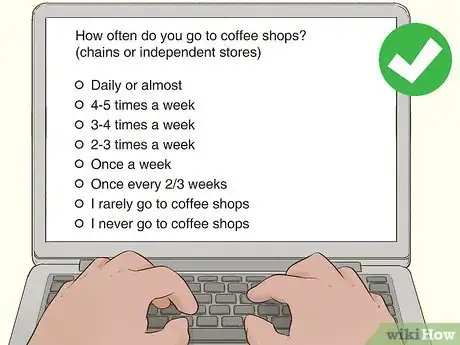This article was co-authored by Brian Honigman. Brian Honigman is a Marketing Consultant and the Owner of Honigman Media LLC. With over a decade of marketing experience, he specializes in consulting with organizations about digital marketing, social media, and content marketing. Brian holds BA in Political Science and Journalism from The University of Pittsburgh. In addition to being a Consultant, Brian is an Adjunct Marketing Professor at New York University and Francisco Marroquín University. His work providing consulting services, training workshops, and coaching programs led to him being named “Digital Marketing Expert” by Entrepreneur and a “Top Social Media Pro” by Social Media Examiner. Brian’s notable clients include The United Nations Development Programme, Thomson Reuters, NATO, and People Magazine.
There are 10 references cited in this article, which can be found at the bottom of the page.
This article has been viewed 42,367 times.
Conducting market research is crucial if you're planning on launching a new product or service. For starters, you'll need to learn about your likely customers, ensure there's demand for your product or service, and figure out how to appeal to consumers.[1] Additionally, study your industry at large, and figure out how to stand out from the competition. Finally, since launching a product or service is a risky endeavor, try to anticipate challenges, and use your research to devise ways to tackle any problems that arise.
Steps
Researching Your Target Customers
-
1Gather demographic information about your consumer base. Learn about your likely audience's age, location, gender, income level, and other details. Gather data from reliable sources, such as government agencies, universities, industry organizations, and trade publications. For instance, you can find plenty of useful demographic information on your government's census website.[2]
- Demographic information can help you figure out who your consumer base is and how to appeal to them.
- If you want to open a coffee shop, for example, researching prospective locations' median income and foot traffic can help you choose the right spot for your business.
- Think about where the customer hangs out online and offline, so you can be active there and catch their attention.[3]
- Brainstorm the customer's goals, and how your product/service could help them achieve those goals.[4]
-
2Design surveys to learn about consumers' needs. Study how consumers buy products or services similar to your own and what factors go into their decision-making process. Keep your surveys short, simple, and straightforward. If possible, offer an incentive for completing the survey, such as a coupon for your product or service.
- Good survey questions include “When choosing which product to buy, which is more important: price or quality,” and “Rank the following list of product features in order of importance, where 1 is most important and 5 is least important.”
- You can use an inexpensive survey hosting website to conduct the survey, hire a market research firm, or administer it yourself.
- If you choose to administer it yourself, you can post it on your social media pages. If you already operate an existing business, conduct the survey through its social media accounts and mailing lists.
Advertisement -
3Find out what kind of messaging resonates with your audience. Investigate where and how you should advertise your product or service. You'll need to learn details like the websites your target customer browses and whether your marketing materials should appeal to logic or emotion, this is also known as Interest Based targeting. Either ask potential customers directly through surveys or look online for published market research.[5]
- Try searching online for university research studies and trade publications on marketing trends related to your product or service.
- Suppose you're a pet groomer and are launching a new boarding service. You'd want to place your ads at strategic spots like pet-related websites or a billboard that overlooks a dog park.
- Your ads also need to convince your audience that your product or service is worth their trust and money. To resonate with your consumer base, for instance, your pet boarding ads need to showcase expertise, reliability, and safe, clean facilities. This can be done with one of the best online marketing ad tool which is known as Remarketing.
- Keep in mind that some marketing opportunities bear fruit more quickly than others. For instance, Google AdWords can get you really fast short-term results, while an SEO strategy takes longer to gain traction.[6]
- If you're a start-up company, limit yourself to 2 types of marketing tactics so you don't overextend yourself.[7]
EXPERT TIPLauren Chan Lee is Senior Director of Product Management at Care.com, the largest online marketplace for finding and managing family care. She has worked in product management for over 10 years across a variety of specialties and areas. She received her MBA from Northwestern University in 2009.Product Leader, Care.com
 Lauren Chan Lee, MBA
Lauren Chan Lee, MBA
Product Leader, Care.comHow are you going to educate your consumer? Lauren Chan Lee, the Senior Director of Product Management at Care.com, says one of the biggest challenges is letting people know a product exists. "When you're launching a new feature, you have to understand how you're going to communicate that feature to customers so they're aware of it. For example, you might send out a quarterly newsletter to keep your customers updated on what you're developing."
-
4Conduct focus groups and trials to refine your product or service. Recruit participants to test your product or service at a focus group or on a trial basis at their home. Have them offer feedback on their experiences, and use that information to make any necessary improvements.
- Testing your product or service can help you prevent hiccups when you actually launch it. You can hire an outside party to conduct focus groups, or recruit participants through social media or your business's network, if you already operate one.
Tip: Before launching your product or service, offer trials, demos, and other promotions to influencers to build hype. For instance, send your new self-cleaning coffee maker to people with major Instagram followings so they'll promote your product.[8]
Analyzing Industry Standards and Competitors
-
1Research businesses competing for your target customers. Find out which other businesses sell products or services similar to your own. Figure out how saturated your market is and how many options consumers have at their disposal. Use that information to decide whether there's enough demand for you to enter the market.[9]
- For instance, if you're opening a hair salon and there are already 4 salons in a neighborhood, it may be hard for you to be competitive in that location.
Tip: You should also look for ways to set yourself apart from the competition. For example, if you're opening a salon, you could offer a service, such as waxing or nail art, that's not available at a neighboring salon.[10]
-
2Investigate pricing and profit margins in your industry. Look into price ranges for products or services of comparable quality as your own. Accounting for parts, supplies, labor, and other costs, make sure you can price your product or service competitively and still make a profit.
- For example, suppose you make jewelry and want to sell it online. If parts for a piece of jewelry cost $15, you spent 4 hours making it, and you set your hourly wage at $15, the item's price needs to be at least $75 ($15 times 4 hours is $60, plus $15 for parts).
- If similar products are significantly less expensive, you could find ways to make your parts cheaper, such as buying in bulk. You could also market your work as exceptional or unique (perhaps your jewelry is made of sea glass from the Amalfi coast), or settle for a lower wage or profit margin.
-
3Study your competitors' brands to differentiate your business. Review your competitors' branding, and look for ways you can stand out from the crowd. Establish who your business is, what promises you're making to consumers, and how you're different from other brands.[11]
- Suppose you want to open a brewery. To set your business apart, you could include a pub and bottle shop that sells a wide variety of beer and wine. While all the neighboring breweries just offer tours and tastings, you could market your brand as a destination that offers something consumers can't find elsewhere.
- A company's brand tells a consumer base who it is and what it offers. A branding strategy communicates that identity through marketing materials, from hashtags to billboards.
-
4Identify your industry's key performance indicators. You'll need measurable, objective standards in order to track your business's progress. These standards are called key performance indicators, and they vary by industry. Learn about how businesses in your industry measure their success by tracking factors such as unique website clicks, profit margins, cost of goods sold, and customer retention rates.[12]
- For example, a restaurant's beer, wine, and spirits cost should be about 20% of its beverage sales ($20 of product should generate $100 in sales). If your bistro's alcohol costs are 29%, you'll need to take steps to improve your performance, such as adjusting your pricing or conducting thorough inventory checks.
- Search online, check trade publications, or talk to an experienced business owner in your network about your industry's specific performance measurements.
Assessing Risks and Problems
-
1Evaluate the reliability of your suppliers and distributors. Identify where you'll source any parts or supplies you'll need and how you'll deliver your product or service to consumers. Make sure you'll have a consistent supply chain, and try to anticipate any problems that could arise. Come up with back-up plans ahead of time in case you need to deal with unforeseen supply chain issues.[13]
- Suppose you're launching a new hot sauce and your recipe depends on a specific dried chili pepper. You'll need to know where to source that specialty product, where you can get it if your primary source falls through, how long it takes to order and receive it, the pepper's shelf life, and how you'll store back stock.
-
2Look up the laws and regulations related to your business. Inevitably, your business will need to comply with one regulation or another, so familiarize yourself with all laws that govern your industry. Additionally, use your research to create contingency plans in the event you run into a compliance issue.[14]
- For example, your hot sauce could get recalled due to faulty packaging, or your pub could fail a health inspection. Knowing packaging standards or health codes in advance can help you prevent issues and promptly resolve any accidents that happen along the way.
-
3Create a list of outside forces and events that could affect your industry. Thinking about what could go wrong isn't fun, but it's important to be realistic about risk. From weather and natural disasters to economic downturn, research the likelihood of forces beyond your control that could threaten your business. Do your best to create strategies to minimize your risk and respond to any outside threats.[15]
- For example, tense political conditions in the country where your hot sauce's chili peppers grow could threaten your production.
- Say your state's legislature has been debating a bill that would raise taxes on the product you're launching. Consider how that would affect your bottom line and whether you could afford to stay in business if it passed.
Expert Q&A
-
QuestionWhat should you check before launching a product?
 Brian HonigmanBrian Honigman is a Marketing Consultant and the Owner of Honigman Media LLC. With over a decade of marketing experience, he specializes in consulting with organizations about digital marketing, social media, and content marketing. Brian holds BA in Political Science and Journalism from The University of Pittsburgh. In addition to being a Consultant, Brian is an Adjunct Marketing Professor at New York University and Francisco Marroquín University. His work providing consulting services, training workshops, and coaching programs led to him being named “Digital Marketing Expert” by Entrepreneur and a “Top Social Media Pro” by Social Media Examiner. Brian’s notable clients include The United Nations Development Programme, Thomson Reuters, NATO, and People Magazine.
Brian HonigmanBrian Honigman is a Marketing Consultant and the Owner of Honigman Media LLC. With over a decade of marketing experience, he specializes in consulting with organizations about digital marketing, social media, and content marketing. Brian holds BA in Political Science and Journalism from The University of Pittsburgh. In addition to being a Consultant, Brian is an Adjunct Marketing Professor at New York University and Francisco Marroquín University. His work providing consulting services, training workshops, and coaching programs led to him being named “Digital Marketing Expert” by Entrepreneur and a “Top Social Media Pro” by Social Media Examiner. Brian’s notable clients include The United Nations Development Programme, Thomson Reuters, NATO, and People Magazine.
Marketing Consultant Check and see what's worked with your marketing strategy thus far, and what's managed to get the customer's attention. If you haven't invested in marketing yet, where have your sales come from? This can help you figure out how to focus and optimize your marketing strategy.
Check and see what's worked with your marketing strategy thus far, and what's managed to get the customer's attention. If you haven't invested in marketing yet, where have your sales come from? This can help you figure out how to focus and optimize your marketing strategy.
References
- ↑ Brian Honigman. Marketing Consultant. Expert Interview. 16 April 2021.
- ↑ https://www.sba.gov/business-guide/plan-your-business/market-research-competitive-analysis
- ↑ Brian Honigman. Marketing Consultant. Expert Interview. 16 April 2021.
- ↑ Brian Honigman. Marketing Consultant. Expert Interview. 16 April 2021.
- ↑ https://www.entrepreneur.com/article/76364
- ↑ Brian Honigman. Marketing Consultant. Expert Interview. 16 April 2021.
- ↑ Brian Honigman. Marketing Consultant. Expert Interview. 16 April 2021.
- ↑ https://www.inc.com/shane-barker/4-things-you-need-to-do-before-you-launch-a-new-product.html
- ↑ https://www.sba.gov/business-guide/plan-your-business/market-research-competitive-analysis
- ↑ https://www.businessnewsdaily.com/5446-porters-five-forces.html
- ↑ https://www.forbes.com/sites/forbesagencycouncil/2017/10/24/18-steps-to-take-before-you-launch-a-product-or-service/#5bc003cd19cf
- ↑ https://www.forbes.com/sites/forbesagencycouncil/2017/10/24/18-steps-to-take-before-you-launch-a-product-or-service/#5bc003cd19cf
- ↑ https://www.investopedia.com/university/business-plan/business-plan4.asp
- ↑ https://www.investopedia.com/university/business-plan/business-plan4.asp
- ↑ https://ctb.ku.edu/en/table-of-contents/assessment/assessing-community-needs-and-resources/swot-analysis/main
About This Article
Researching the market before releasing a new product or service can be intimidating, but by focusing on your target customers and getting to know your chosen industry, you can prepare a strong launch. Use government agencies and trade publications to gather demographic information about your customers, like age, gender, and location, so you can tailor your advertising to their interests. You could also release a short survey to find out how consumers buy products or services like yours. Since you’ll be competing with other businesses, find out how they operate and how much they charge for their products so you can offer an attractive alternative. Additionally, research their advertising strategies to help you come up with ways to stand out from the crowd. For tips from our Business co-author on how to research potential risks, such as external events or legal regulations, keep reading!






























































